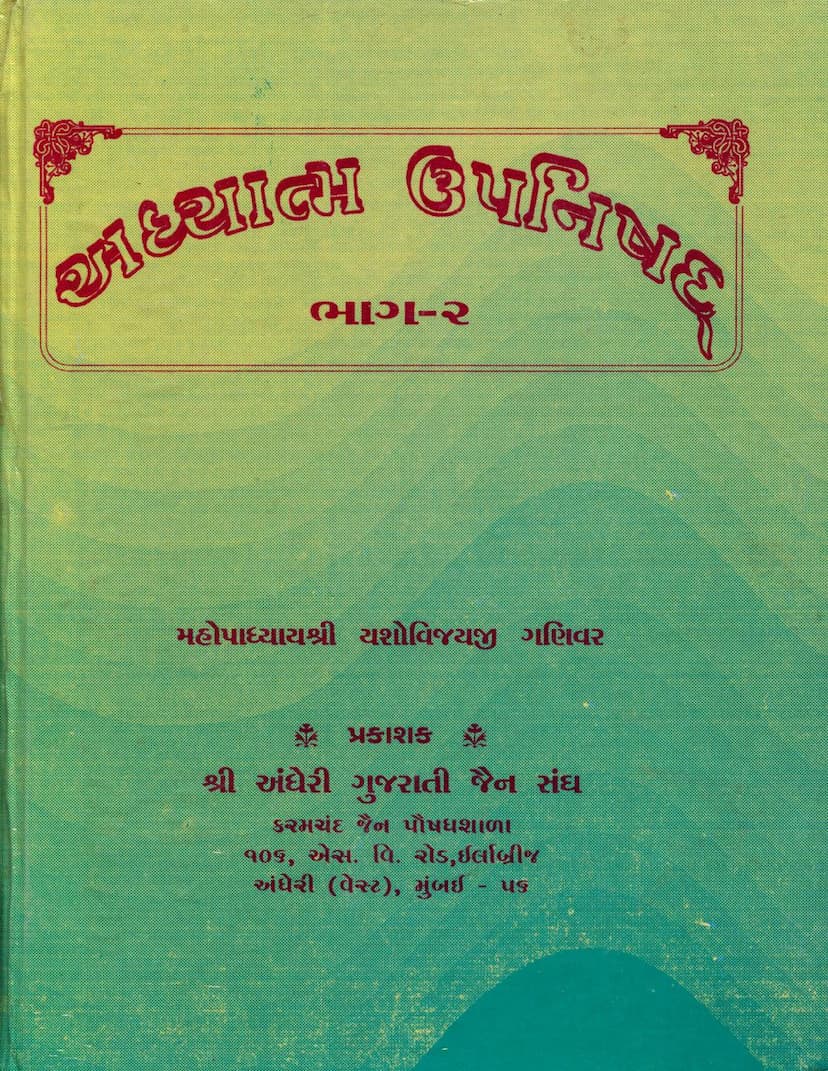Adhyatma Upnishad Part 02
Added to library: September 1, 2025

Summary
The "Adhyatma Upanishad Part 02" by Yashovijay Gani, published by Shri Andheri Gujarati Jain Sangh, is the second volume of a spiritual discourse focusing on the path of Adhyatma (spiritual realization). This book is a commentary on the original text, enriched with the Adhyatma Vaishardi (Sanskrit commentary) and Adhyatma Prakash (Gujarati commentary) by Muni Yashovijay. The work is presented under the divine blessings of Acharya Shrimad Vijay Bhuvan Bhanu Surishwarji Maharaj and the guidance of Siddhanta Divakar Acharya Shrimad Vijay Jayghosh Surishwarji Maharaj, with research and contribution from Acharya Shrimad Vijay Jagatprabh Surishwarji Maharaj and Panyas Pravar Shrimad Jayasundarvijayji Ganivar.
The book is structured to guide spiritual seekers, emphasizing the distinction between material and spiritual pursuits. It highlights that true happiness is not found in accumulating material possessions but in self-realization. The text is divided into four main sections:
-
Shastrayoga (Scriptural Path): This section defines Adhyatma based on two perspectives (nay) – Vyavahar (conventional) and Nishchay (ultimate reality). It explains Adhyatma as the diligent practice of the five acharas (conducts) – knowledge, perception, character, penance, and energy – with the soul as the focus. It discusses the importance of abandoning negative conduct like ignorance and blind faith, and embracing knowledge-based practices for self-realization. The text also introduces the concept of three-fold scripture examination (kash, chhed, and taap – scraping, cutting, and heating tests, akin to gold purity testing) to discern true scripture from the multitude of texts available. This involves aligning scripture with the ultimate goal, demonstrating useful and harmless practices, and presenting truths from multiple perspectives (anekantavada).
-
Gyanayoga (Path of Knowledge): This section delves into the path of knowledge (Gyanayoga) for deeper understanding of the soul, particularly Pratibha-jnana (intuitive insight). It explains that this knowledge is distinct from scriptural knowledge (Shruta) and pure knowledge (Kevala) and arises from specific spiritual practices (yoga). It differentiates between the stages of spiritual practice, from initial to perfected states, where worldly subjects lose their allure, becoming like illusions (Mahendrajaal). The text emphasizes that true knowledge (Gyan) and happiness (Sukha) are ultimately one, experienced through direct self-realization, transcending all worldly conditions. It cautions against incomplete understanding and highlights the importance of detachment and equanimity.
-
Kriyayoga (Path of Action): This section underscores the significance of action (Kriyayoga) in spiritual progress, even for those with profound knowledge. It criticizes the notion that outward actions become irrelevant with spiritual advancement, warning against self-indulgence. The text asserts that action is crucial both for achieving spiritual states and for maintaining them, comparing knowledge without action to knowing the way without traveling it. It argues that actions, even if seemingly outward, purify the mind and contribute to spiritual progress. The importance of virtuous actions is highlighted, stating that even a learned person who acts carelessly is no different from a dog eating impure food.
-
Samyayoga (Path of Equanimity): This final section describes the ultimate state of Samyayoga (equanimity), where the soul, united with the self-realized nature, is described metaphorically as being in a chariot pulled by two horses of knowledge and action. It emphasizes that in this state, the aspirant is unaffected by external obstacles. The text beautifully portrays the elevated state of the equanimous practitioner, comparable to the sthitaprajna (one with steady wisdom) in the Bhagavad Gita. It explains that true equanimity stems from deep contemplation of the soul, leading to the cessation of desires and the attainment of inner peace. The text illustrates this through the lives of various saints and sages who exemplified equanimity amidst adversity.
Throughout the book, the author, Yashovijay Gani, meticulously weaves together scriptural wisdom, logical reasoning, and practical guidance to illuminate the path of Adhyatma. The commentaries by Muni Yashovijay clarify the profound Sanskrit verses, making the complex philosophical concepts accessible to a wider audience. The book ultimately guides the reader towards self-realization and liberation, emphasizing the integration of knowledge, action, and equanimity.